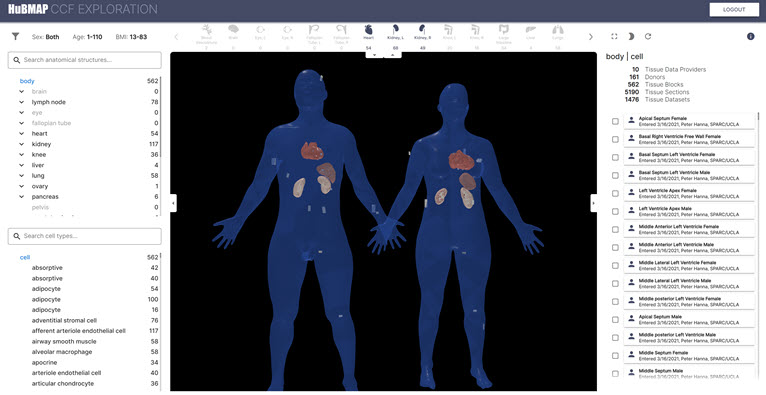Companion Website for “Tissue Registration and Exploration User Interfaces in Support of a Human Reference Atlas”
Katy Börner1*, Andreas Bueckle1*, Bruce W. Herr II1, Leonard E. Cross 1, Ellen M. Quardokus1, Elizabeth G. Record1, Yingnan Ju 1, Jonathan C. Silverstein2, Kristen M. Browne3, Sanjay Jain 4, Clive H. Wasserfall5, Marda L. Jorgensen 5, Jeffrey M. Spraggins6, N. Heath Patterson7, Griffin M. Weber 8
- 1 Department of Intelligent Systems Engineering, Luddy School of Informatics, Computing, and Engineering, Indiana University, Bloomington, Indiana, USA
- 2 Department of Biomedical Informatics, University of Pittsburgh School of Medicine, Pittsburgh, Pennsylvania, USA
- 3 Department of Health and Human Services, National Institute of Allergy and Infectious Diseases, The National Institutes of Health, Bethesda, Maryland, USA
- 4 Department of Medicine, Washington University School of Medicine, Saint Louis, Missouri, USA
- 5 Departments of Pathology and Pediatrics, University of Florida, Gainesville, Florida, USA
- 6 Department of Cell and Developmental Biology, Mass Spectrometry Research Center, Vanderbilt University School of Medicine, Nashville, Tennessee, USA
- 7 Department of Biochemistry, Mass Spectrometry Research Center, Vanderbilt University School of Medicine, Nashville, Tennessee, US
- 8 Department of Biomedical Informatics, Harvard Medical School, Boston, Massachusetts, USA
Join our effort!
Experts interested in joining this international effort are invited to register at https://iu.co1.qualtrics.com/jfe/form/SV_bpaBhIr8XfdiNRH to receive regular updates and invites to relevant meetings that aim to advance the construction and usage of a human reference atlas.
Exploration User Interface (EUI)
All tissue datasets used in this study can be explored in their three-dimensional size, position, and rotation in the context of the Human Reference Atlas. Using the Exploration User Interface (EUI), you can:
- Select an organ: Navigate available organs by selecting them from the carousel above the stage or using the ontology on the left.
- Filter: Above the Search is the filter icon which opens a flyout with many options (e.g., Sex, Assay Types, etc.) for refining what tissue data is presented.
- Registered Blocks: Select a block of tissue samples by using either the bodies on stage or the cards in the right column. Color coding helps to identify different selections.
- Data: Using the cards in the right column, click on items to dig deeper into the data.
Human Reference Atlas (HRA) Dashboard
Note: This dashboard only shows published data. The number of tissue blocks and tissue sections shown may differ from the number registered in the HuBMAP ecosystem but not published yet.
The HRA Dashboard displays the number of tissue blocks, tissue sections, and RUI locations per reference organ, organ, and tissue provider for HuBMAP data. This is an interactive visualization for all public HuBMAP data. Note that EUI counts are higher as data by HCA, GTEx, and other consortia are included.
Exemplary CCF-HRA 3D Models
The CCF 3D Reference Object Library provides anatomically correct reference organs. The organs are developed by a specialist in 3D medical illustration and approved by organ experts.
Reference objects are created using data from the Visible Human Project male and female datasets provided by the National Library of Medicine. The male dataset comprises 1,871 cross-sections at 1mm intervals for both CT and anatomical images at a resolution of 4,096 pixels by 2,700 pixels. The female data set has the same characteristics as the Visible Human Male but axial anatomical images were obtained at 0.33 mm intervals resulting in 5,189 cross-section anatomical images. The male was white, 180.3 cm (71 inch) tall, 199-pound and was 38 years old. The female was white, 171.2 cm (67.4 inch) tall, obese, and 59 years old.
In December 2021, a total of 25 reference organs became available in GLB format. Each organ can be viewed and explored using free web browsers such as Babylon.js.
You can explore all the 3D models of the CCF-HRA at https://hubmapconsortium.github.io/ccf/pages/ccf-3d-reference-library.html
3D model of the Visible Human Project's male left kidney (left) and female heart (right).

